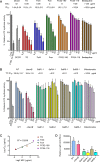Tomatidine Is a Lead Antibiotic Molecule That Targets Staphylococcus aureus ATP Synthase Subunit C
- PMID: 29610201
- PMCID: PMC5971568
- DOI: 10.1128/AAC.02197-17
Tomatidine Is a Lead Antibiotic Molecule That Targets Staphylococcus aureus ATP Synthase Subunit C
Abstract
Methicillin-resistant Staphylococcus aureus (MRSA) is a leading cause of deadly hospital-acquired infections. The discovery of anti-Staphylococcus antibiotics and new classes of drugs not susceptible to the mechanisms of resistance shared among bacteria is imperative. We recently showed that tomatidine (TO), a steroidal alkaloid from solanaceous plants, possesses potent antibacterial activity against S. aureus small-colony variants (SCVs), the notoriously persistent form of this bacterium that has been associated with recurrence of infections. Here, using genomic analysis of in vitro-generated TO-resistant S. aureus strains to identify mutations in genes involved in resistance, we identified the bacterial ATP synthase as the cellular target. Sequence alignments were performed to highlight the modified sequences, and the structural consequences of the mutations were evaluated in structural models. Overexpression of the atpE gene in S. aureus SCVs or introducing the mutation found in the atpE gene of one of the high-level TO-resistant S. aureus mutants into the Bacillus subtilis atpE gene provided resistance to TO and further validated the identity of the cellular target. FC04-100, a TO derivative which also possesses activity against non-SCV strains, prevents high-level resistance development in prototypic strains and limits the level of resistance observed in SCVs. An ATP synthesis assay allowed the observation of a correlation between antibiotic potency and ATP synthase inhibition. The selectivity index (inhibition of ATP production by mitochondria versus that of bacterial ATP synthase) is estimated to be >105-fold for FC04-100.
Keywords: ATP synthase; Staphylococcus aureus; new target; small-colony variant; tomatidine.
Copyright © 2018 American Society for Microbiology.
Figures




References
-
- Review on Antimicrobial Resistance 2014. Antimicrobial resistance: tackling a crisis for the health and wealth of nations. The Review on Antimicrobial Resistance, London, United Kingdom: https://amr-review.org/sites/default/files/AMR%20Review%20Paper%20-%20Ta....
Publication types
MeSH terms
Substances
LinkOut - more resources
Full Text Sources
Other Literature Sources
Medical
Molecular Biology Databases

